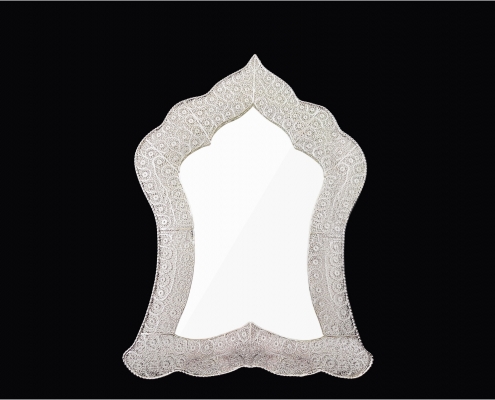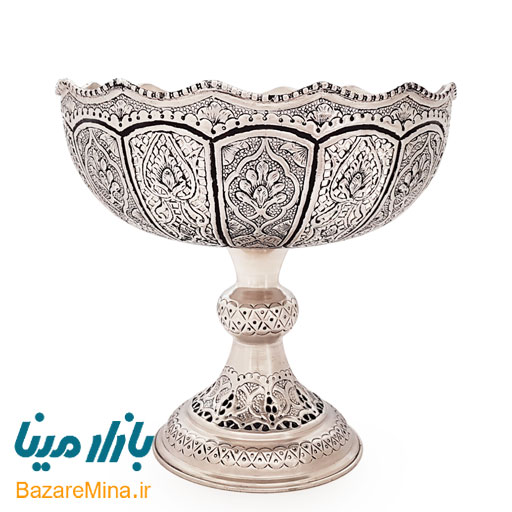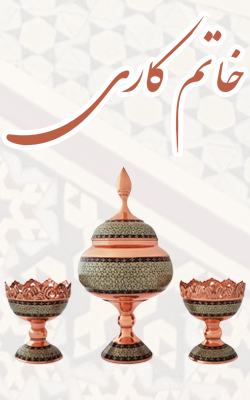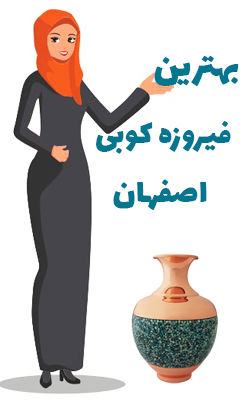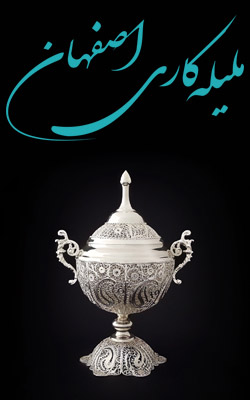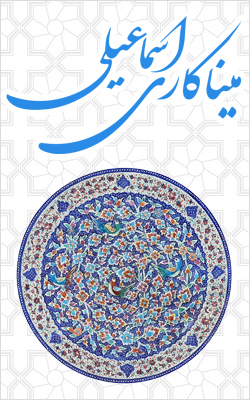- نویسنده: امید حسینی
Iranian filigree is one of the most beautiful handicrafts of Isfahan. The attractive color and delicate designs of this artwork is magnificent enough to attract the attention of people. Filigree of Isfahan is a beautiful art and handicraft which is fabulous. It is generally made of copper and a coating of silver covers it. You can buy this Persian Handicrafts which is remained from past and enjoy looking at its fabulous designs and materials. Some people consider it as a luxurious item to decorate their showcases. Introduction Filigree of Isfahan is a fantastic artwork which is a branch of metal working. Previously, gold and silver were considered as the main materials used in this art, but as gold and silver are expensive metals, copper replaced them. Filigree was famous in Zanjan before Pahlavi Era; while, Isfahan has had the highest location for long years. Different works of filigree are also seen in Tehran, Khorasan and some countries like Bulgaria and Spain.
Filigree is a kind of art with decorative and practical aspects, which is made by putting some narrow metal strips to make some designs such as flowers and leaves. 100 percent Karat silver is needed to make filigree bars which should be melted and changed into beautiful art of filigree of Isfahan to make beautiful products. The handicraft will have a higher quality if delicacy and cleanliness is followed while producing it.

Filigree of Isfahan
Filigree of Isfahan has been famous for long years because it has a luxurious look. It is generally made of copper with a silver coating which makes a nice color. Designs worked on filigree of Isfahan are taken from traditional and natural designs and the most important ones are different types of flowers, leaves and tears. Filigree products of Isfahan are made of narrow strips of copper and silver with high delicacy and precision to make memorable handicrafts which are usually considered as beautiful and luxurious artworks of Isfahan. These dishes were used in the past by people in high social levels of the society.
History of Filigree
Filigree is one of the dishes which was found in archeological discoveries which dates back this art to Achaemenid Era. Later in Sassanid Era, filigree dishes were generally made of silver and some of them had gemstones to be more beautiful. This art was found in different discoveries in Shush and Hamedan which shows its old background. Filigree was mainly made of gold and silver by the evolution of Islam. The art of filigree belongs to Isfahan and Zanjan and different handles of cup, sugar pot and trays were made of filigree. This handicraft is part of the metal working art.
Filigree Making
Filigree making is done in workshops of Isfahan under the supervision of skillful masters who work in this field for long years. Although a lot of time and effort is needed to make a great item, its price is not very expensive. This handicraft was a typical piece of art in Zanjan before Pahlavi Era. Later, most masters of this art immigrated to Isfahan and Tehran; so people in different cities got familiar with this great handicraft. During this period, tea services, knife handles and jewelry boxes were the most popular samples which were decorated with some gemstones. The milestone of this artwork was from Seljuk Era, when most masters of this art moved from northeast Iran to some cities such as Zanjan and Borujerd; and it had a peak in Safavid Era. Also, in Qajar Era, different earrings, trays and cups were made with filigree of Isfahan, which are kept in national and international museums.

There are a variety of products with different sizes and designs which are made with this exquisite art; such as tray, cup and glass holder, teaspoon, sugar pot, vase, rose-water sprinkler, flower, frame, fruit dish, sweet dish and a lot of other products. There are some differences between the filigree of Isfahan and that in Zanjan; while, handicrafts of Isfahan are made of higher quality materials. At the moment, filigree is made on copper products with a silver coating because it is more common and reasonable.

Persian Filigree
Process of Making Filigree of Isfahan
Persian filigree is among popular handicrafts of Isfahan with an influential role in the development of art and culture because other nations can be familiar with it. In order to make a filigree product, you need to follow some steps as the following:
• Melt a bar of silver
• Mold it into narrow strips of 5 mm
• Heat the strips
• Shape strips by hammer
• Make narrow wires by heating the strips and passing them in rolling machine
• 0.5 mm diameter wires are known as filigree
• Wax rectangular iron surface
• Choose the mold of your preferred dish
• Stick wax to the dish
• Put a wide silver strip around the mold to get its shape
• Pick up the walls
• Close filigree ends with iron wires
• Solder the wires
General Points about Filigree of Isfahan
Although the appearance of high quality filigree products is similar to that in low quality ones, there are some points which can help you choose the best one:
• The product which you buy should have a certificate and its karat should be written on a part of the product.
• Put the dish in front of the sunlight. If the color of dish changes to black or yellow, it does not have a high quality.
Isfahan Filigree
Isfahan filigree is inherited from past generations so much care and attention should be paid for its preservation. The beauty of this art is undeniable and has attracted the attention of numerous art lovers. Different factors are necessary to estimate the price of a filigree product; such as material, plating and delicacy. Filigree is a kind of art which highly flourished in Safavid Era. It is a popular art these days and people consider it as a gift to their acquaintances or use it to decorate their showcases. If you feel interested in learning this art, you can take a training course and work in a workshop under the supervision of a professional master to learn the ropes of this art and start making precious dishes with filigree of Isfahan. It can improve the recruitment of people, especially the youth, and try to transfer this handicraft to different parts of the world.
Filigree is a fabulous art because it is made of copper with a silver coating and its delicate pattern and color creates a magnificent view. A variety of filigree vases are the best choice for your home’s decoration. You can also serve your guests with coffee or tea in a filigree tray accompanied by a filigree coffee service or tea service including a filigree sugar pot and filigree galoshes. A nice suggestion to newly married couples is to buy a set of filigree mirror and filigree candlesticks for their wedding to bring luck and happiness.

If you want to have these products for a long time, you have to pay attention to some precautions:
• Keep the products away from water and humidity. It is advisable not to wash these dishes with water and chemical detergents because they will damage the body of filigree products.
• You should not keep filigree products in front of the direct sunlight because they will be damaged and their color will be changed.
• You can clean filigree products with a dry cloth if they are dirty.
If you put dishes of filigree of Isfahan in a dry and cool place without exposure to humidity, you can keep them for a long time and take advantage of their luxurious appearance and practical usage. Master Mohammad Rafi’ is one of the eminent masters of filigree of Isfahan who learned this art from Master Hanani. He followed traditional type of filigree making and added some innovations to make it more updated. He believes that filigree is more delicate on silver and gold, but because of the expensive price of these metals, copper is generally used which is covered with a silver coating.
The biggest difference between filigree of Isfahan and that of Zanjan is the innovation. Filigree of Isfahan is made based on innovation and patterns in mind so most the dishes have different patterns; while, filigree of Zanjan has a special pattern and it does not have any special creativity. By paying more attention to different handicrafts, especially those in Isfahan, as center of art and culture, more people will get familiar with a variety of artworks. It will results in more economic growth and people who work in this field can earn money to live and work.








